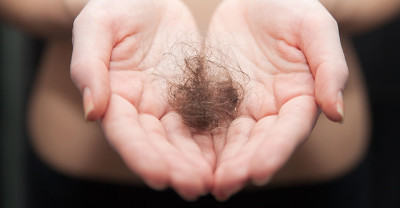- Home
- Editorial
- News
- Practice Guidelines
- Anesthesiology Guidelines
- Cancer Guidelines
- Cardiac Sciences Guidelines
- Critical Care Guidelines
- Dentistry Guidelines
- Dermatology Guidelines
- Diabetes and Endo Guidelines
- Diagnostics Guidelines
- ENT Guidelines
- Featured Practice Guidelines
- Gastroenterology Guidelines
- Geriatrics Guidelines
- Medicine Guidelines
- Nephrology Guidelines
- Neurosciences Guidelines
- Obs and Gynae Guidelines
- Ophthalmology Guidelines
- Orthopaedics Guidelines
- Paediatrics Guidelines
- Psychiatry Guidelines
- Pulmonology Guidelines
- Radiology Guidelines
- Surgery Guidelines
- Urology Guidelines
Good News for Baldies-New drug reverses hair loss

An experimental drug successfully reversed the hair loss, hair whitening and skin inflammation in a series of experiments with mice that were first fed a diet high in fat and cholesterol, according to the findings of Johns Hopkins researchers published in the journal Scientific Reports.
According to the investigators, compound prevents the production of certain fats called glycosphingolipids, or GSLs, that are major components of skin and other cell membranes. GSLs are prevalent in the cells that make up the uppermost layer of the skin, as well as in cells called keratinocytes that help regulate pigmentation of the eyes, skin, and hair. During the experiment, mice were fed with the diet rich in fat and cholesterol which caused hair discoloration from black to gray to white, extensive hair loss and inflammation of skin exhibited by multiple wounds. However when such mice were fed with the compound their symptoms reversed.
"Further research is needed, but our findings show promise for someday using the drug we developed for skin diseases such as psoriasis, and wounds resulting from diabetes or plastic surgery," says Subroto Chatterjee, Ph.D., M.S., M.Sc., professor of pediatrics and medicine at the Johns Hopkins University School of Medicine. Chatterjee conducts research as part of Johns Hopkins Children's Center.
The researchers warned that such results in mice may not show the same results in human beings and there is no evidence of the safety of the drug. But the findings may pave a new way for addressing hair loss and skin wounds in humans with oral or topical medications.
Read Also: Caution: Bitter pumpkin soup may cause hair loss
Chatterjee and his associates conducted a study to determine how disrupting GSLs might affect skin appearance and color, and whether treatment with D-threo-1-phenyl-2-decanoylamino-3-morpholino-1-propanol (D-PDMP) -- a man-made compound that halts GSL production -- would reverse any negative effects.
The experimental mice were divided into two groups; one group of these mice were fed with a Western diet high in fat and cholesterol, and the other group with standard chow. All mice were fed their assigned diets from 12 weeks of age to 20 weeks.
The study found that compared to those fed standard chow, the mice that ate a Western diet lost hair, formed skin lesions and suffered from hair whitening. These results became more severe when the mice continued eating a Western diet for 36 weeks, with 75 percent of the mice having skin, hair loss, and multiple skin lesions.
From 20 to 36 weeks of age, mice in both groups were given varying amounts of D-PDMP, either in a capsule or as a liquid, while they ate the same diet. Mice that received 1 milligram and 10 milligrams of D-PDMP in a capsule per kilogram of body weight from 20 to 36 weeks while eating a Western diet started regaining hair and hair color, and their skin inflammation lessened. Treatment with 1 milligram of D-PDMP in a capsule per kilogram of body weight was as effective as 10 milligrams per kilogram as a liquid. This suggests that an encapsulated form of D-PDMP is a better method of drug delivery.
The skin of the mice's was observed under a microscope. The microscopic view showed that eating the Western diet experienced an infiltration of neutrophils, a type of white blood cell implicated in inflammation, in various skin areas. Treatment with D-PDMP in a capsule significantly reduced the number of neutrophils, implying reduced skin inflammation and wounding.
Up next, the researchers used mass spectrometry analysis, a method of identifying and quantifying the chemical composition of a mixture, to determine ceramide, glucosylceramide and lactosylceramide levels in the mice. Ceramides are a type of lipid, or fat, that helps protect the skin's moisture, and glucosylceramide is the first derivative of ceramide, whereas lactosylceramide, a later derivative of ceramide, activates inflammation.
The study found that compared to mice fed normal chow, those fed a Western diet had decreased total ceramide levels, decreased glucosylceramide and nearly three times more lactosylceramide. Treatment with 1 milligram of D-PDMP in a capsule per kilogram of body weight or 10 milligrams of D-PDMP as a liquid per kilogram of body weight, however, noticeably increased ceramide levels to normal.
The researchers warranted the need for more animal research to confirm and expand on the findings and to determine how well and what amount of D-PDMP might heal wounds and activate hair growth.
For reference log on to https://www.nature.com/articles/s41598-018-28663-9

Disclaimer: This site is primarily intended for healthcare professionals. Any content/information on this website does not replace the advice of medical and/or health professionals and should not be construed as medical/diagnostic advice/endorsement or prescription. Use of this site is subject to our terms of use, privacy policy, advertisement policy. © 2020 Minerva Medical Treatment Pvt Ltd